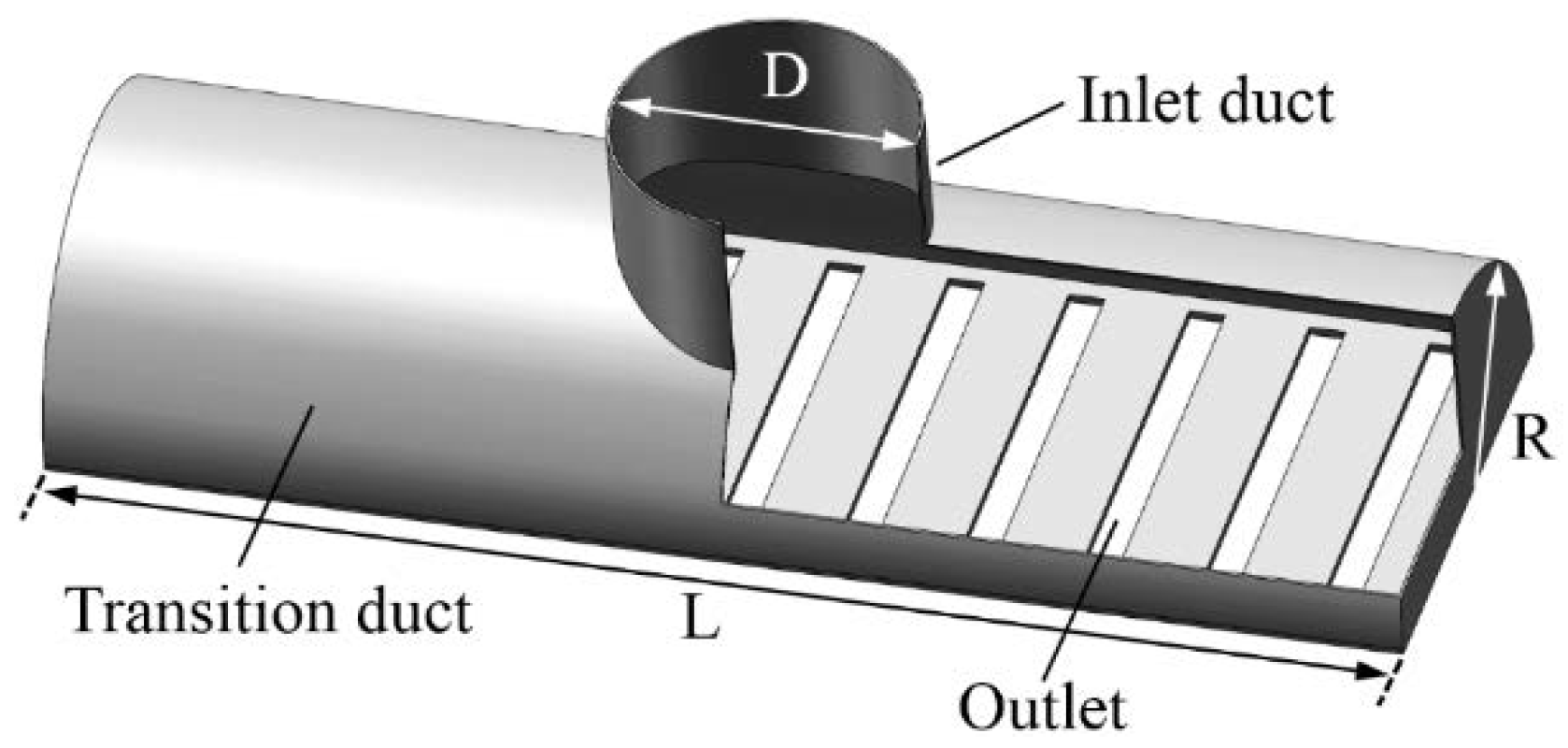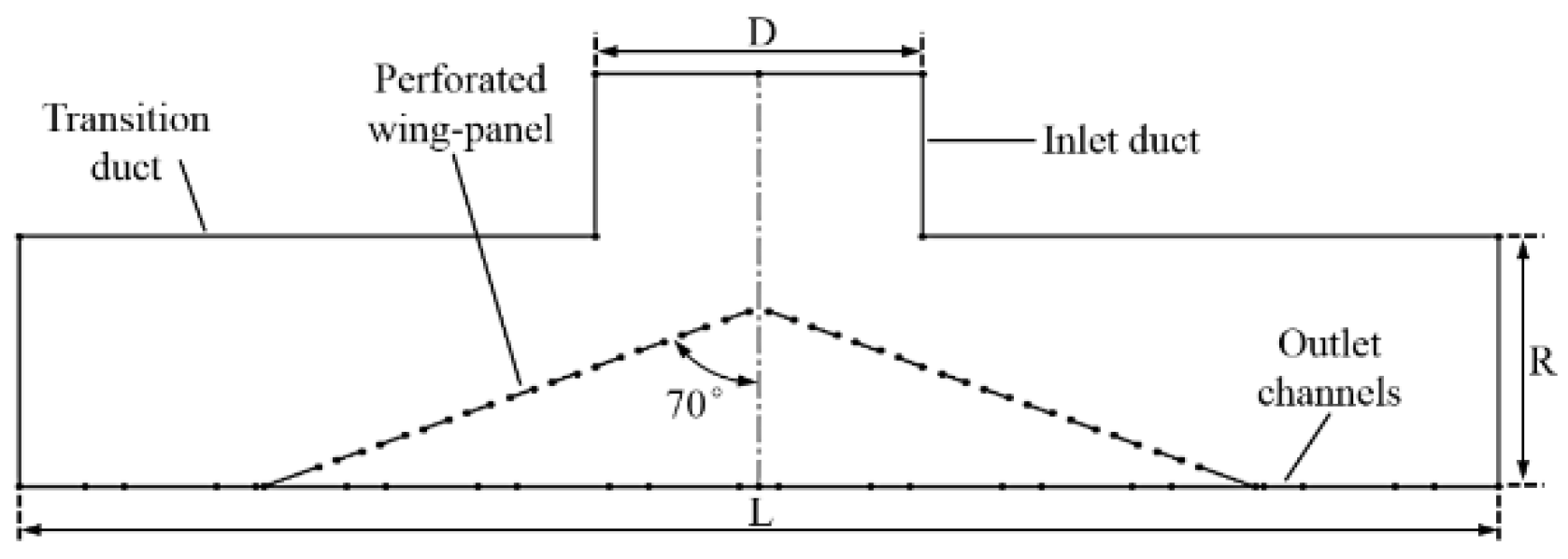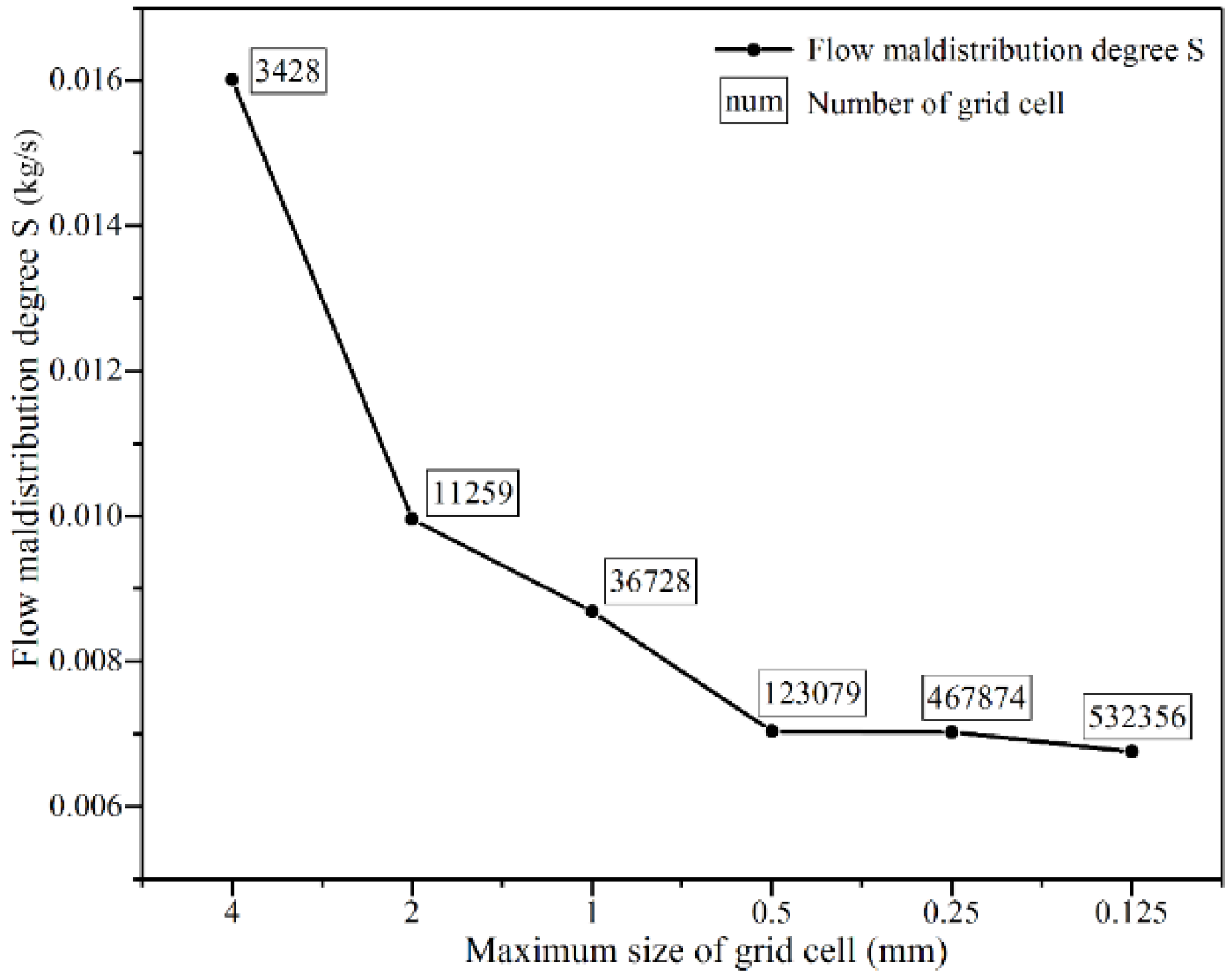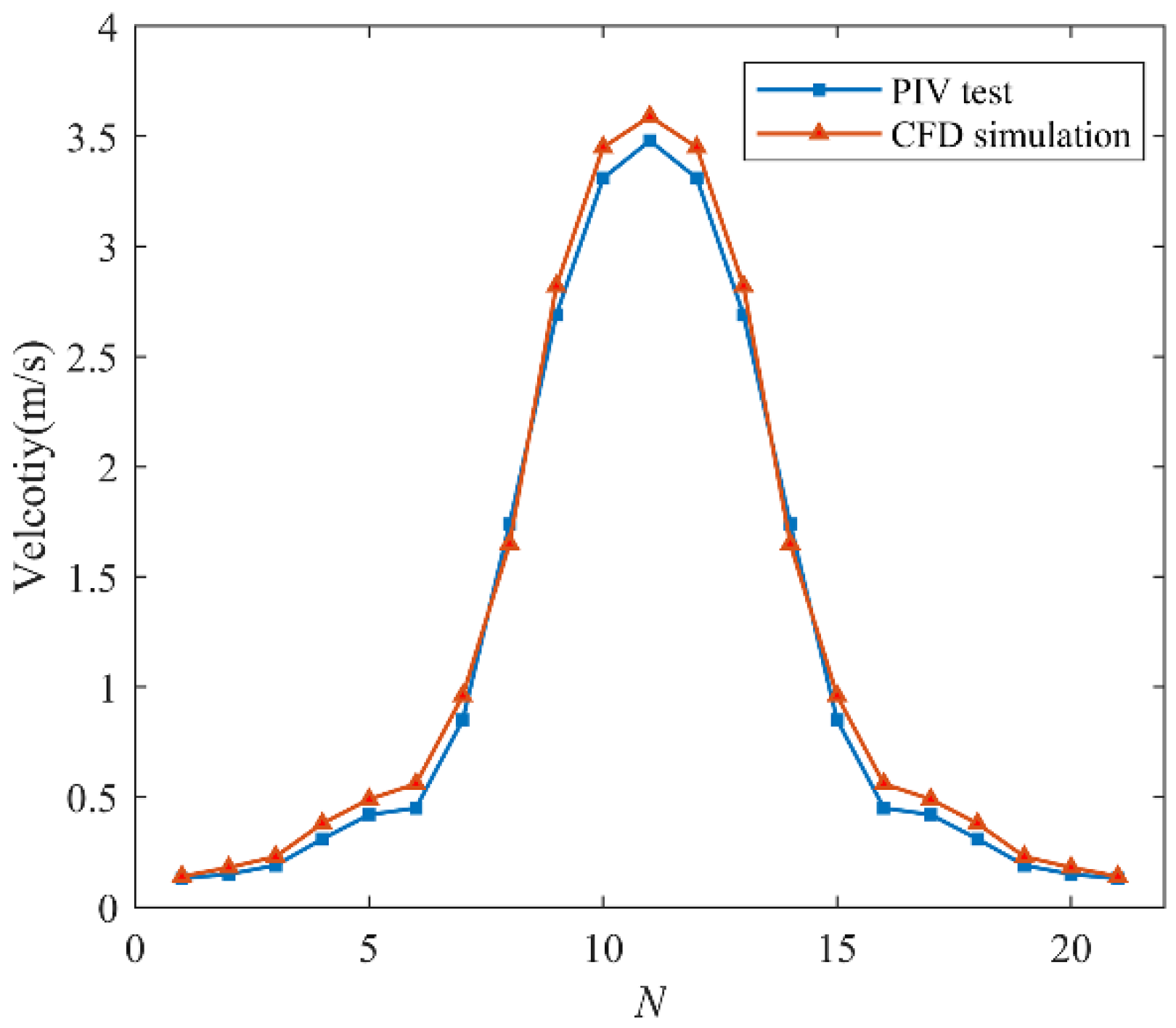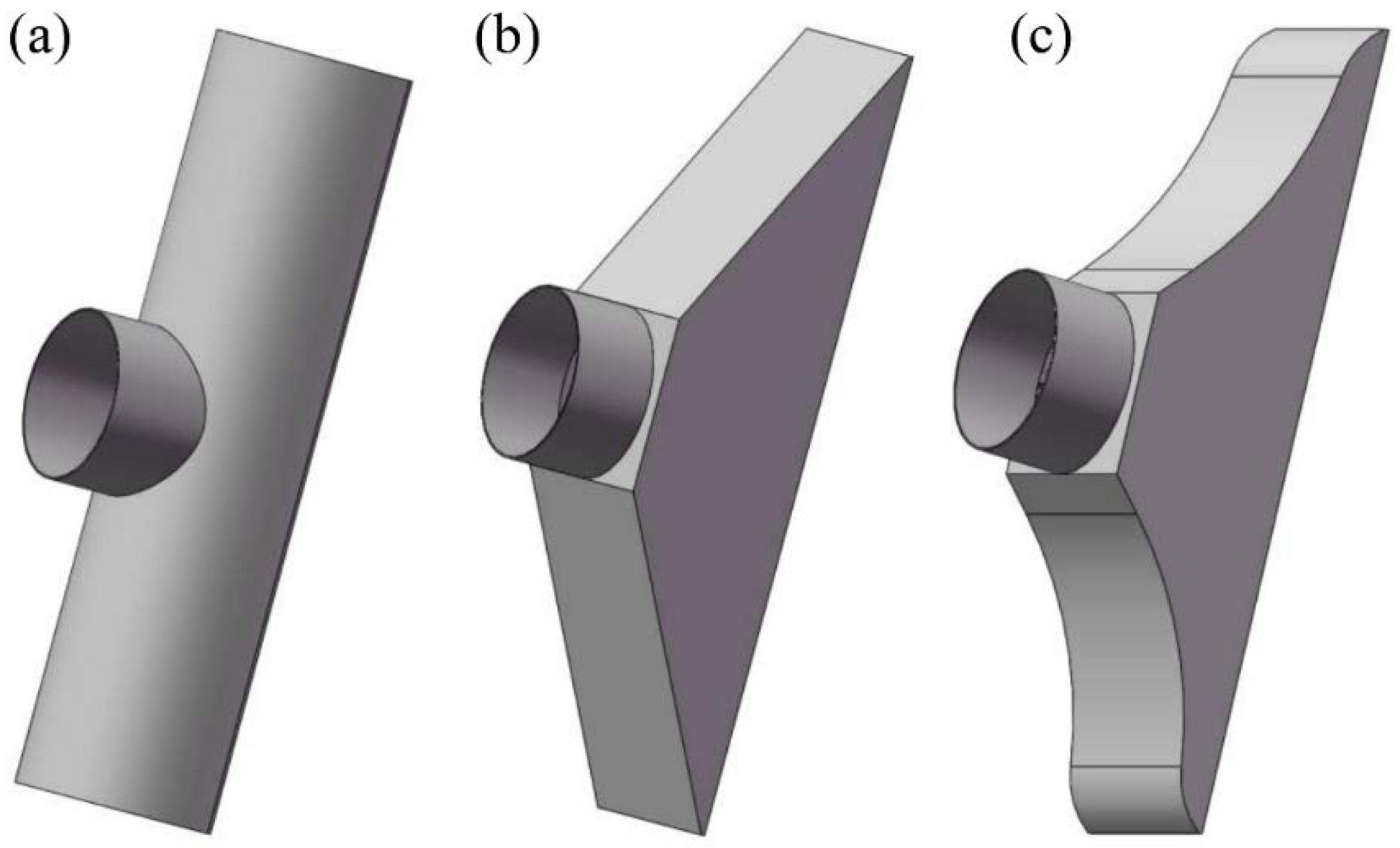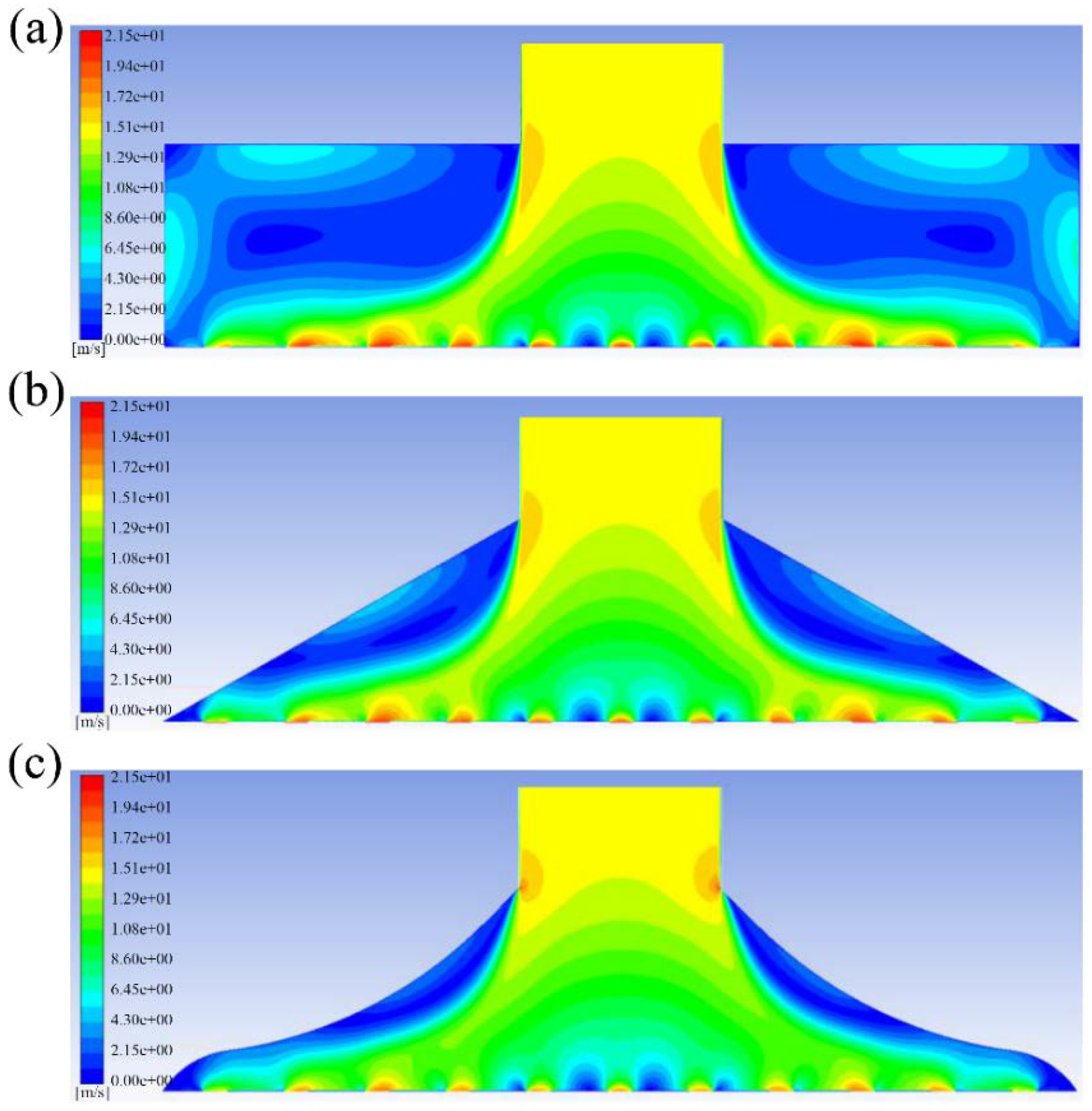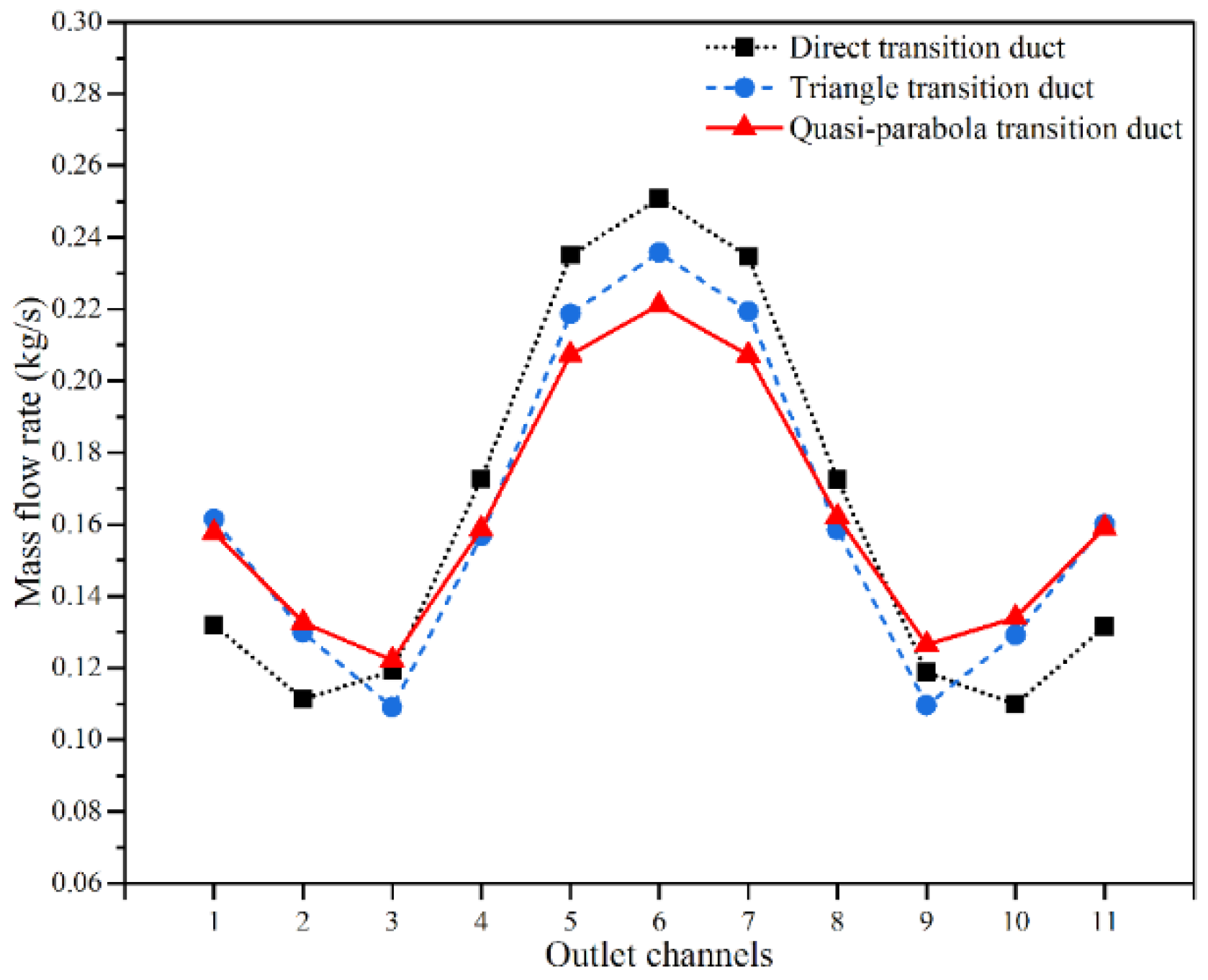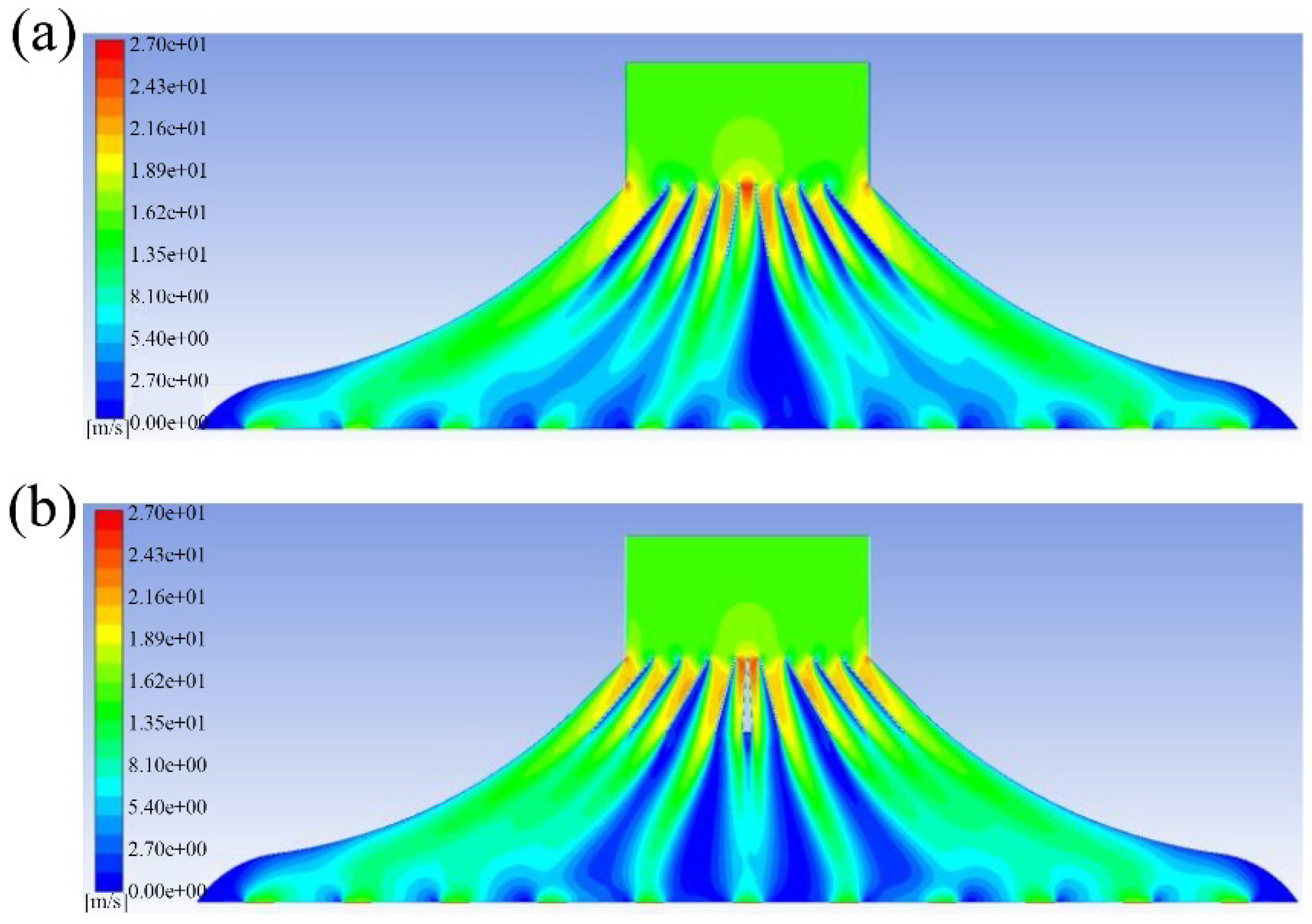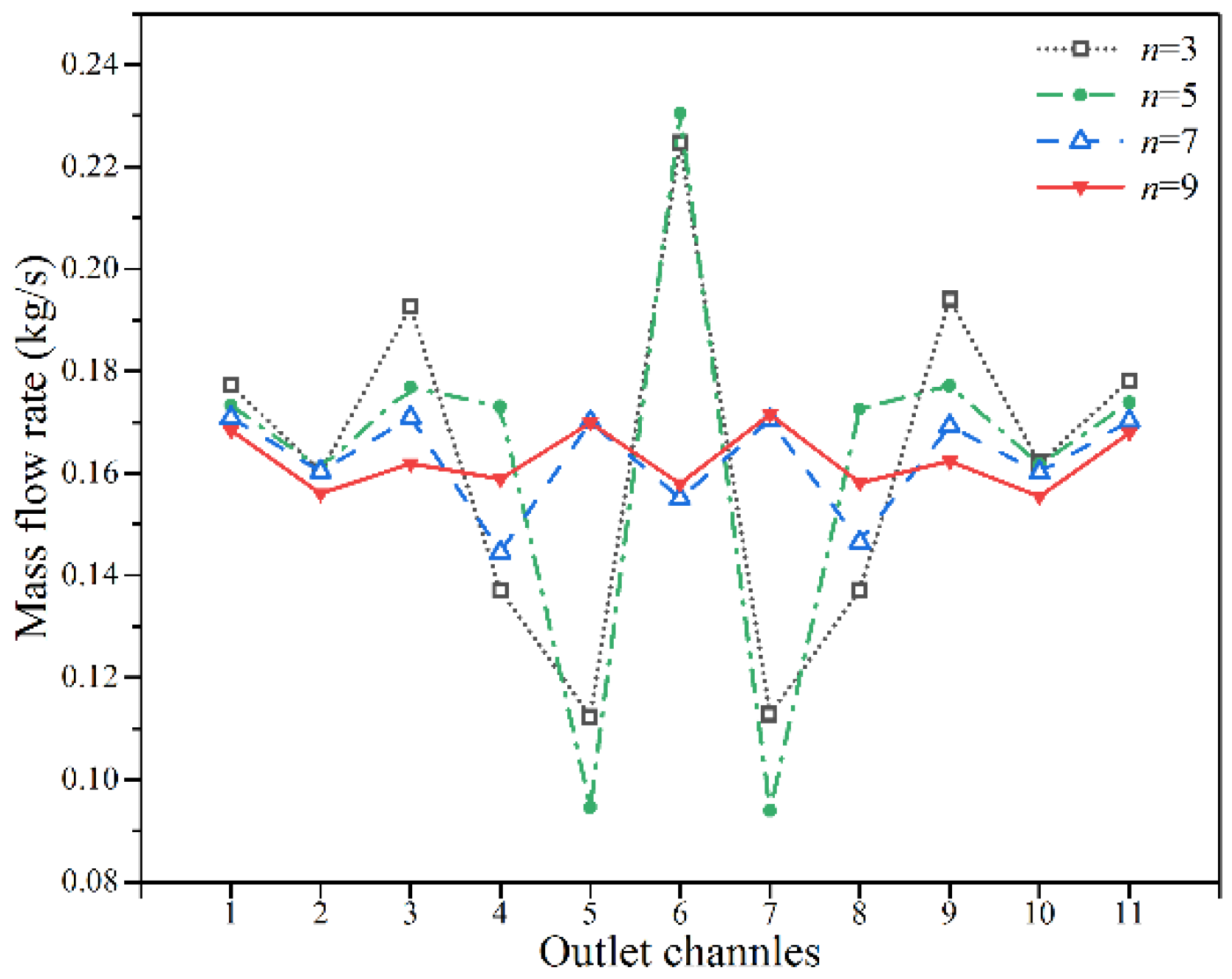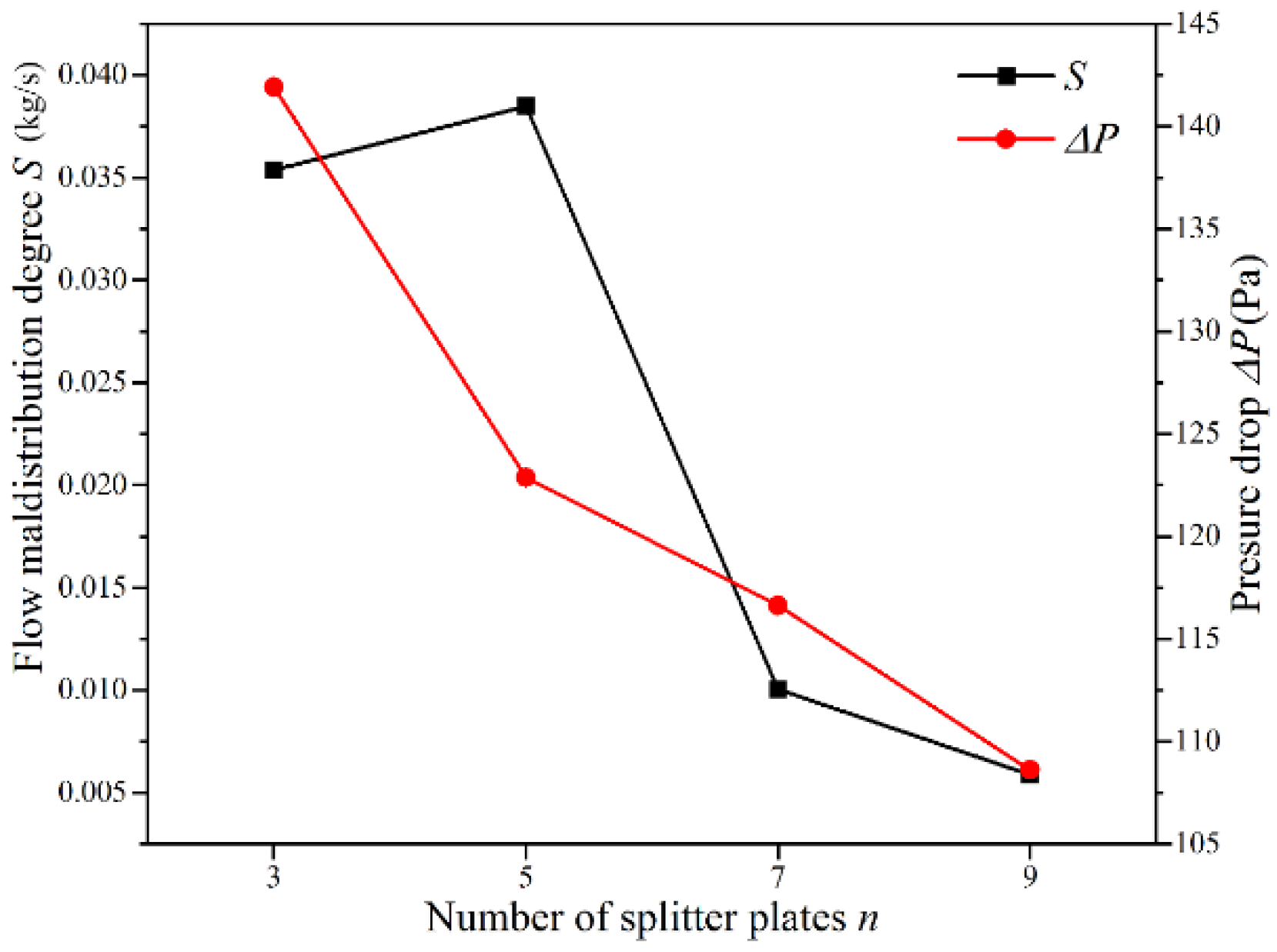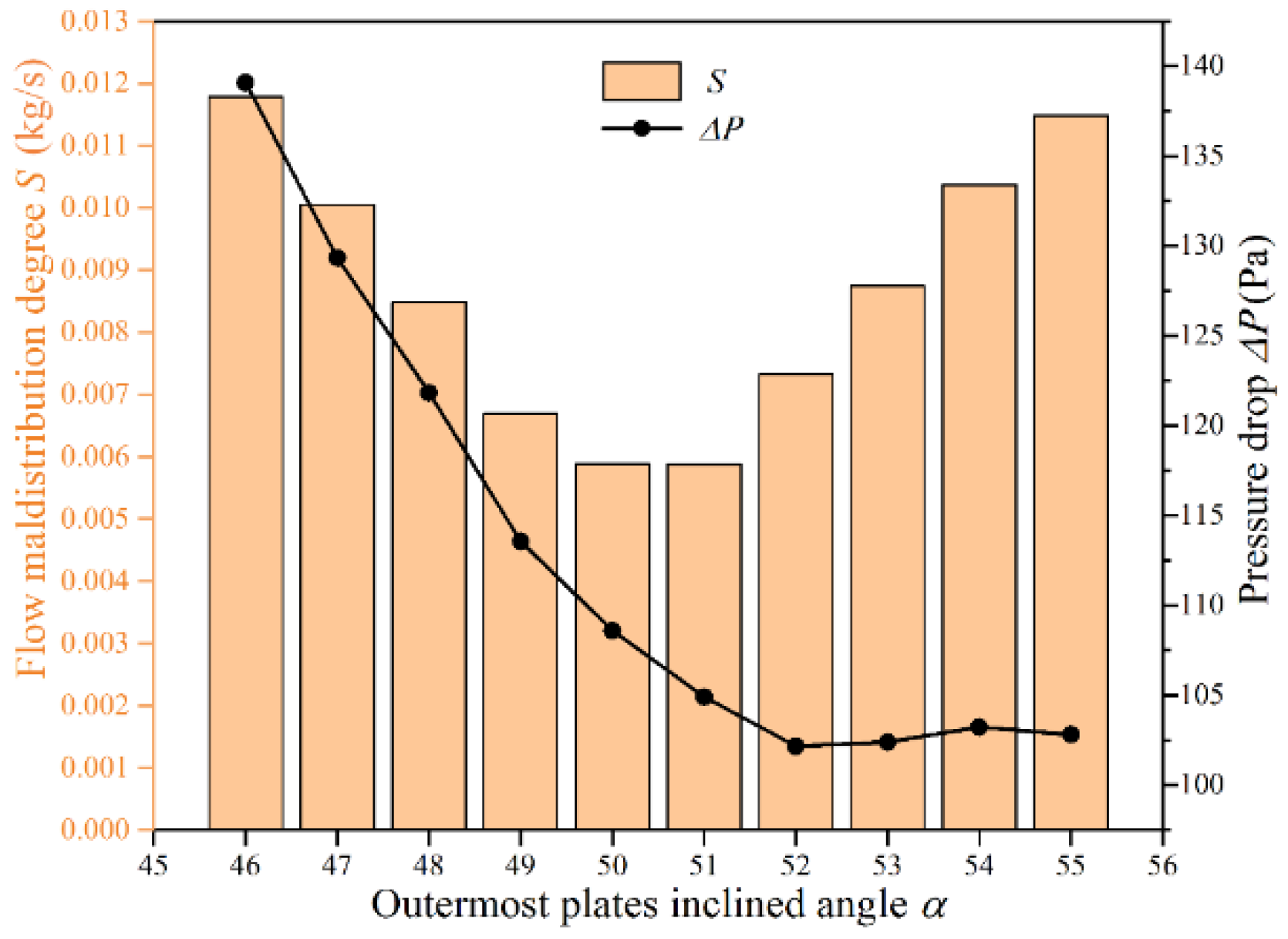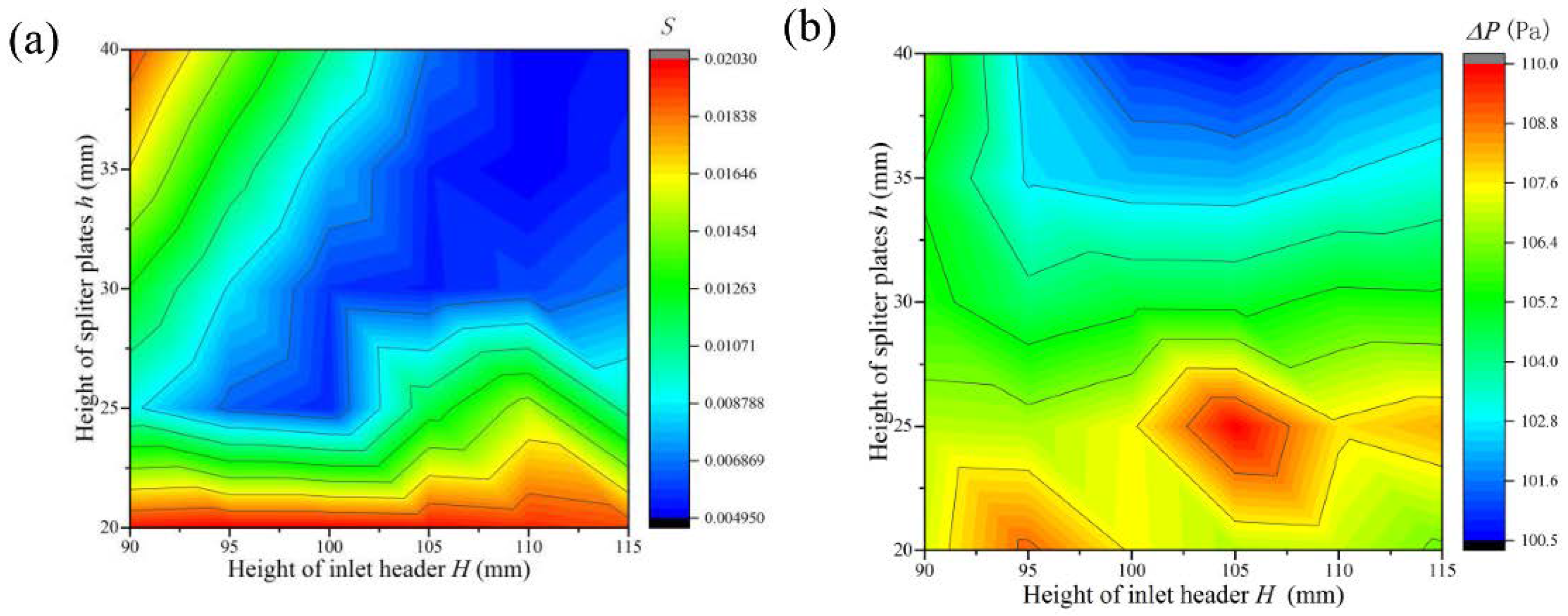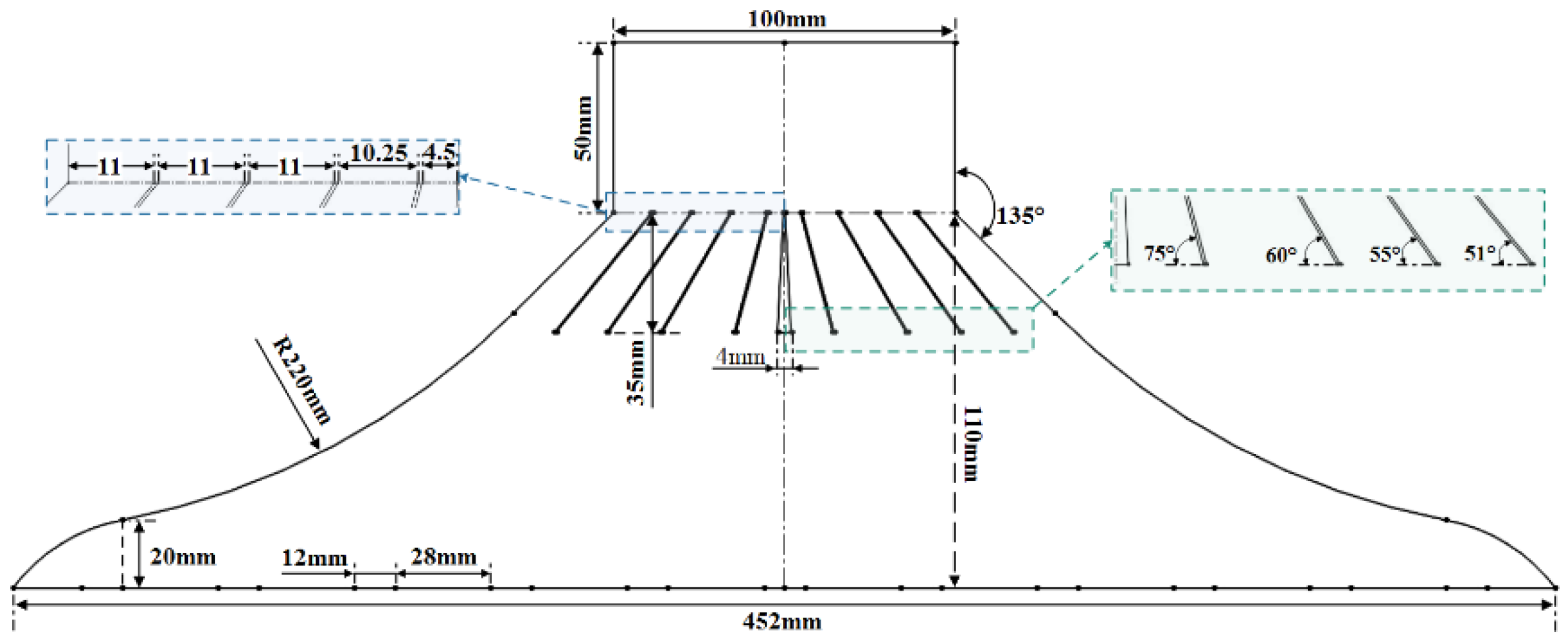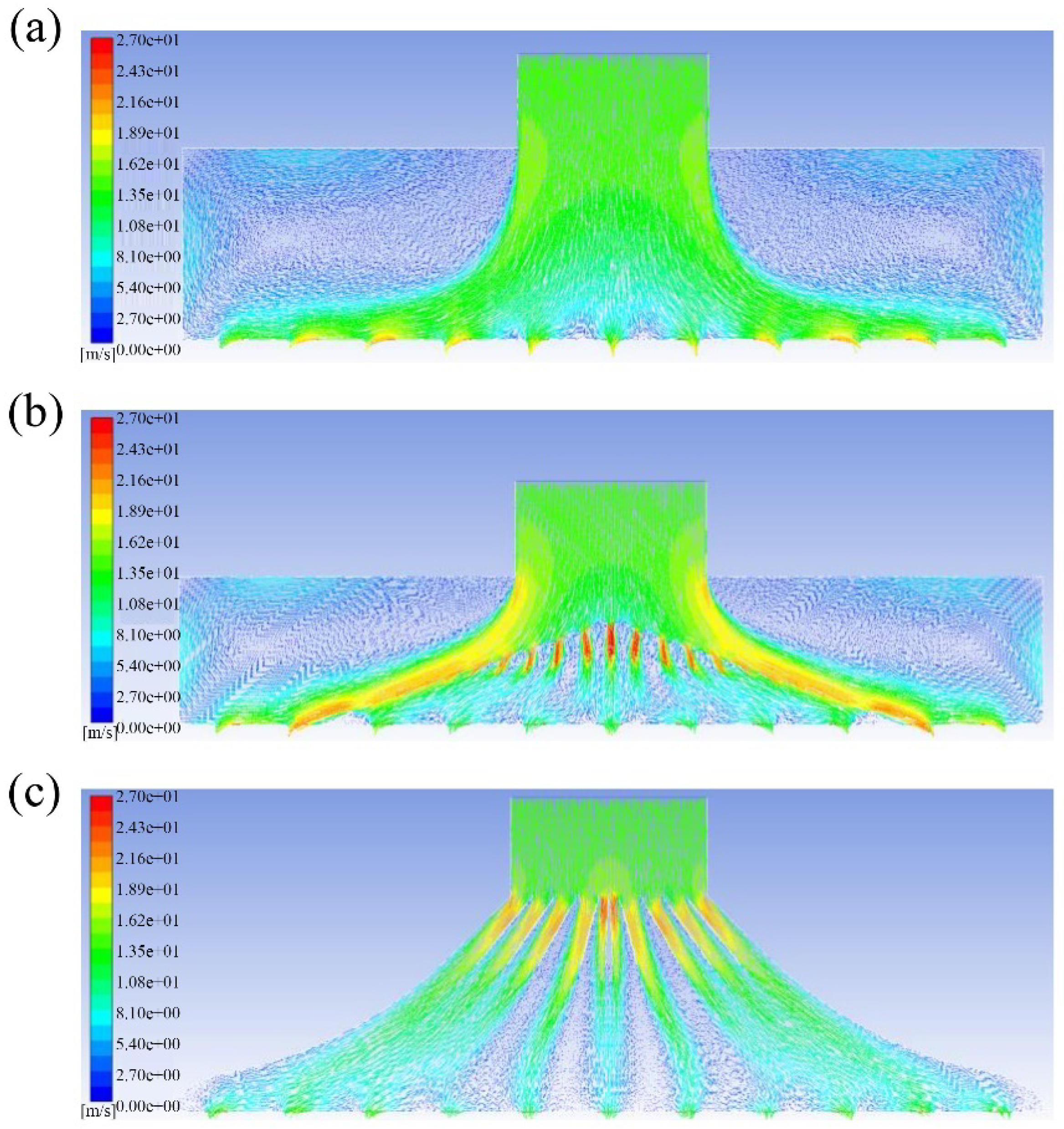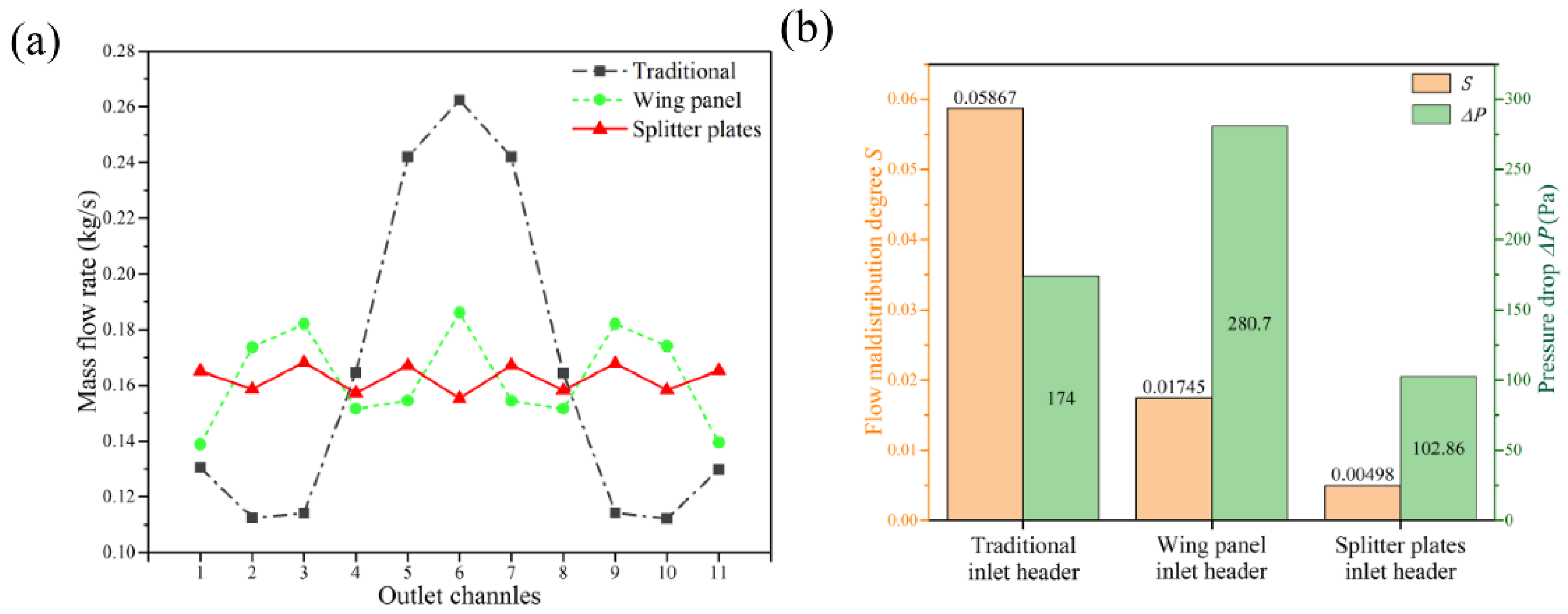1. Introduction
Multi-stream plate-fin heat exchangers (MPFHEs) are widely used in many applications, including as air separation units, the aerospace industry, in buildings, and for cryogenic liquefaction due to a high heat transfer efficiency, high heat transfer surface-area-to-volume ratio, and low weight [
1,
2]. MPFHEs are constructed of an inlet header, fin channels, and an outlet header. The hot and cold fluids are assumed to be uniformly distributed among different fin channels in many thermal design methodologies for MPFHEs, such as the logarithmic mean temperature difference (LMTD) method [
3] and the effectiveness-number of transfer units (ε-NTU) method [
4]. However, it is impossible to distribute these fluids to different channels uniformly in the inlet header, and uneven flow commonly exists in the actual operation conditions.
The reasons for flow maldistribution can be divided into geometry design features and variational operation conditions. Geometry design features include the improper design of the header, manufacturing tolerances, and structural differences among the different channels. The variational operation conditions include the flow velocity changes along the headers, the fluid viscosity, and the multiphase flow [
5,
6].
Flow maldistribution in the inlet header and its effects on the thermal performances were investigated using theoretical analysis, computational fluid dynamic (CFD) simulations, and experimental testing technologies in the past few decades [
7,
8]. Lalot [
9] calculated the outlet velocity ratio to represent the flow maldistribution, and the results indicated that the gross flow maldistribution led to a loss of effectiveness of about 7% for counterflow heat exchangers and up to 25% for crossflow exchangers. Rao [
10] presented an experimental investigation analyzing the influence of flow maldistribution on the pressure drop of heat exchangers, the results indicated that maldistribution was more severe in Z-type plate heat exchangers compared to U-type plate heat exchangers. Chin [
11] analyzed the influences of four statistical moments (mean, standard deviation, skew and kurtosis) of inlet flow maldistribution on the thermal performance of MPFHE, results indicated that the mean and standard deviation had the highest effects on the performance degradation, whereas kurtosis had no significant effect. Salehi [
12] determined that the optimum baffle location in the inlet header was the middle distance between inlet ducts and heat transfer plates, which could improve the flow maldistribution in the inlet header and effectiveness of heat exchanger with input Reynolds numbers of 250–3000 Niroomand [
13] developed a quasi-three-dimensional model of MPFHE which considered the influences of inlet flow maldistribution and transverse heat conduction simultaneously.
After quantitatively determining the flow maldistribution in the inlet header, some attempts were made to decrease the deteriorating influences on the thermal performance of MPFHEs. These can be classified into two types: (1) Structural optimization of the inlet header to decrease inlet flow maldistribution; and (2) partial thermal compensation in the fin channel region. For the thermal compensation of flow maldistribution, Jung [
14] proposed the transverse bypass structure among the channels of hot streams or cold streams, and the improved thermal effect was quantitatively analyzed and verified in a practical heat exchanger. Peng [
15] decreased the thermal deterioration influence of inlet flow maldistribution through coordinate optimization design of passage arrangement and inlet mass flow rates.
Although thermal performances can be partially compensated using improvements of fin channels and passage arrangement, the improvement effectiveness of thermal performances is limited as there are serious flow maldistribution upon entering fin channels, which cannot be eliminated in fin channels. Structural optimization of inlet header is the main technology used to improve the thermal performances. Jiao [
16] put forward the concept of second header to improve the flow maldistribution, then Wen [
17] proposed a second header configuration with a baffle plate containing small holes to improve flow maldistribution. Ismail [
18] proposed an improved baffle plate with varying dimensions of arranged holes, which could decrease the pressure drop compared with traditional baffle plates with uniform holes. Yaïci [
19] improved the geometrical parameters, such as longitudinal tube pitches, transversal tube pitches, and fin pitches, to decrease flow maldistribution. Yang [
20] proposed an improved quasi-S-type header configuration, which could reduce the maldistribution parameters by 89.9%–91.8% compared with a traditional inlet header in typical plate-fin heat exchanger. Tu [
21] investigated a modifying inlet nozzle configuration with porous baffles, which could decrease the flow maldistribution by 52.0% for the gas phase and 47.5% for the liquid phase.
Although many modified inlet header configurations have been proposed and these modifications improved the flow maldistribution, the pressure drop and flow resistance of the heat exchanger were also increased. To solve these issues, we proposed a new inlet header configuration with splitter plates to decrease the flow maldistribution and pressure drop simultaneously. The novelty of this work is its presentation of a new inlet header configuration with splitter plates which can decrease the flow maldistribution and pressure drop simultaneously. The results of this work can be used to guide the structural design of inlet header for plate-fin heat exchanger. The paper is organized as follows:
Section 2 describes the proposed new inlet header configuration with splitter plates, and the CFD calculation model was established to analyze the flow distribution and pressure drop of the improved inlet header. In
Section 3, we detailed the sensitivity analysis between geometry parameters, flow maldistribution degree, and pressure drop, and determined the optimum structural configuration of improved inlet header. In
Section 4, we compared the flow maldistribution and pressure drop between the proposed inlet header and two traditional inlet headers to verify the effectiveness of the proposed configuration. Our conclusions are summarized in
Section 5.
3. Optimization Design of Structural Parameters for Improved Inlet Header
The influences of the transition duct between inlet duct and header core, number of splitter plates n, the inclined angle of the outermost plates , the height of splitter plates h, and the height of inlet header H on flow maldistribution degree S and pressure drop were analyzed, and the optimal configuration of improve inlet header with splitter plates were determined.
3.1. Transition Duct Construction Between Inlet Duct and Header
There were multiple types of transition duct constructions between the inlet duct and header in the existing configurations of the inlet header. Three typical transition ducts were compared in the improved inlet header, including a direct transition duct (
Figure 6a), triangle transition duct (
Figure 6b) and quasi-parabola transition duct (
Figure 6c).
Figure 7 shows the velocity distribution in the inlet header with different transition ducts. The mass flow rates at outlet channels under the three transition ducts are shown in
Figure 8. There was a mutation between the equivalent diameters of the direct transition duct and the outlet channels of the header, two reverse flow regions were formed, and the flow maldistribution degree reached 0.0543 kg/s. The reverse flows can be decreased using the triangle transition duct and quasi-parabola transition ducts. Compared with the triangle transition duct, the velocity gradient was smoother, and the velocity mutation was less using the quasi-parabola transition duct. Results indicate that the difference between the maximum and minimum mass flow rates was decreased and the flow maldistribution degree of quasi-parabola transition duct was 0.0348 kg/s, which was 78.6% of the flow distribution degree in the triangle transition duct. Therefore, the quasi-parabola transition duct was applied in the following improved inlet header.
3.2. Number of Splitter Plates n
The number of splitter plates
n can be an odd number or even number. If
n is an odd number, one splitter plate is installed at the center position facing the inlet duct, and the other splitter plates are symmetrically installed on both sides of the central plate. If
n is an even number, all splitter plates are symmetrically installed in the inlet header. The velocity distribution in the header with
and
are shown in
Figure 9. With
, high velocity differences were observed at the central splitter plate, which increased the flow maldistribution and pressure drop. Therefore, the flow maldistribution was lower using an odd number of splitter plates.
The mass flow rates at outlet channels under different odd numbers
n = 3, 5, 7, and 9 of splitter plates were calculated and listed in
Figure 10. The corresponding flow maldistribution degrees and pressure drops are shown in
Figure 11. When the number of splitter plates increased from 3 to 5, the flow maldistribution degree
S increased from 0.0354 kg/s to 0.0385 kg/s because the air flow velocity in the central region was suddenly increased. As the number of splitter plates increased from 5 to 9, the flow maldistribution degrees
S were 0.0385 kg/s, 0.01005 kg/s, and 0.0059 kg/s, respectively. The flow maldistribution degrees were decreased because the air flow velocities in the direction of length
L were increased, which can decrease the flow maldistribution. If
was further increased to 11 or more, the distance between adjacent splitter plates will be too small to manufacture due to the size limitations of inlet header. Therefore, the optimum number of splitter plates was
when considering the influences of flow maldistribution, pressure drop, and structural constraints simultaneously.
3.3. Inclined Angle of Outermost Splitter Plates
The inclined angle of the outermost splitter plates
has an important influence on the angles of other splitter plates and the air flow condition in the header. Therefore, the air flow simulations with different
were implemented in Fluent, and the other parameters were determined as
H = 100 mm,
h = 30 mm, and
n = 9. The flow maldistribution degree
S and pressure drop
are shown in
Figure 12. The pressure drop was decreased as the increase of inclined angle
. As inclined angle value
increased, the transverse flow effect was improved, the mass flow rates at both sides of outlet channels were increased and the flow maldistribution degree
S was decreased. However, when the inclined angle value
was too high, the transverse flow effect was very serious, the mass flow rates in middle region of outlet channels were low, and the flow maldistribution degree
S was also increased. The minimum value of
S was 0.005876 kg/s at
and
. The pressure drop
at
was 104.9 Pa, which was smaller than 108.6 Pa at
. Therefore, the optimum inclined angle of the outermost splitter plate was
.
3.4. Inlet Header Height H and Splitter Plate Height h
The inlet header can be divided into splitter region and mixture region. In the splitter region, the air is split to different regions by multiple splitter plates, and then the air is mixed through horizontal flows in the mixture region.
The height of inlet header H and the height of splitter plates h determine the area ratio of splitter region and mixture region. If the value of H is high and the value of h is low, the splitter effectiveness is poor, and a reverse flow may appear in the mixture region due to a high flow velocity in the central region. If the value of H is low and the value of h is high, the split air cannot be sufficiently mixed in mixture region and the transverse velocities cannot be significantly reduced. Therefore, the height of inlet header H and height of splitter plates h should be coordinated optimized to improve the flow maldistribution and pressure drop in the inlet header.
Table 1 and
Table 2 list the flow maldistribution degrees
S and pressure drop
under multiple different combinations of inlet header height
and splitter plate height
. The other structural parameters were
and
. The corresponding contour maps of flow maldistribution degrees and pressure drops are shown in
Figure 13.
The difference between the maximum and minimum pressure drop was 7.54 Pa, which indicates that the two structural parameters had little influences on the pressure drop. However, the height of inlet header H and the height of splitter plates h had important influences on the flow maldistribution degree S. The maximum value of S was 0.020286 kg/s when H = 95 mm and h = 20 mm, and the minimum value of S was 0.004958 kg/s when H = 110 mm and h = 40 mm. The difference of S was 0.000020 kg/s between H = 110 mm, h = 40 mm and H = 110 mm and h = 35 mm, which was very little. However, the total weight of inlet header can be decreased through decreasing h. Therefore, considering the effectiveness of flow maldistribution, pressure drop and total weight of inlet header simultaneously, the optimum height of inlet header H and height of splitter plates h were determined as H = 110 mm and h = 35 mm, respectively.
3.5. Optimum Configuration of Improved Inlet Header
Based on the analysis results, the optimum configuration of improved inlet header is shown in
Figure 14. The transition duct between inlet duct and header was a quasi-parabola transition duct, the number of splitter plates was
n = 9, the inclined angle of the outermost plates was
, the height of inlet header was
H = 110 mm, and the height of splitter plates was
h = 35 mm. The angles of other splitter plates and the distances between adjacent plates are also listed in
Figure 14. Using the optimum structure, the flow maldistribution degree was
S = 0.004978 kg/s, and the pressure drop was
.
4. Performance Comparison among Three Inlet Header Configurations
The flow maldistribution degrees and pressure drop of three inlet header configurations (Configuration A in
Figure 1, Configuration B in
Figure 2, and Proposed Configuration C in
Figure 14) were compared to verify the effectiveness of the proposed inlet header configurations.
The diameter of inlet duct
D and the construction of outlet channels for the three inlet headers were the same. The velocity distributions in the three types of inlet headers are shown in
Figure 15. The corresponding velocity distributions of outlet channels, flow maldistribution degrees, and pressure drops are shown in
Figure 16. Compared with the traditional inlet header (Configuration A), the flow maldistribution degree
S was decreased by 70.3% using inlet header for Configuration B, while the pressure drop was increased by 61.3% because the flow resistance was increased at the splayed perforated wing panels. Using the proposed improved inlet header (Configuration C), the flow maldistribution degree
S was decreased by 91.5%, and the pressure drop was also decreased by 40.9%. The pressure drop may have been decreased due to (1) the angle between the inlet flow direction and splitter plates being small, which decreased the friction pressure drop; and (2) the diversion effect of splitter plates making the fluid flow in a specific direction, which reduced the inverse flow in the inlet header. Therefore, the improved inlet header can effectively enhance the flow uniformity and decrease the pressure drop.
5. Conclusions
An improved inlet header configuration with splitter plates for a plate-fin heat exchanger was proposed to decrease the flow maldistribution and pressure drop simultaneously. A computational fluid dynamic simulation was implemented to calculate the velocity distribution and pressure drop in inlet header, and the grid independence test determined the maximum sizes of grid cells to be 0.5 mm.
The influences of the transition duct between inlet duct and header, the number of splitter plates , the inclined angle of the outermost plates , the height of splitter plates h, and the height of inlet header H on the flow maldistribution degree S and pressure drop were analyzed, and the optimum configuration in the calculation condition was determined to be the quasi-parabola transition duct, with n = 9, , H = 110 mm, and h = 35 mm.
In comparison with the traditional inlet header, the improved inlet header can decrease the flow maldistribution degree by 91.5% and the pressure drop by 40.9%, which is better than the inlet header with splayed perforated wing panels, which decreased the flow maldistribution degree S by 70.3% and increased the pressure drop by 61.3%. Therefore, the proposed improved inlet header can enhance the flow uniformly and heat transfer rates effectively, which can improve the total heat transfer rates of plate-fin heat exchanger.
Notably, the proposed inlet header configuration is independent from the operation conditions. Some further research can be implemented in the future:
(1) Regarding the other specific inlet mass flow rates or inlet Reynolds numbers, the specific structural parameters of the improved inlet header can be determined using the method in
Section 3. In this way, the optimization design considering multiple operation conditions can be researched.
(2) Only the inlet header was analyzed in this work. The improvement effectiveness for thermal performance in the fin regions for the improved inlet header can be studied in the future.
(3) The influences of manufacturing, installation, and operation on the performance of proposed inlet headers can also be researched.
